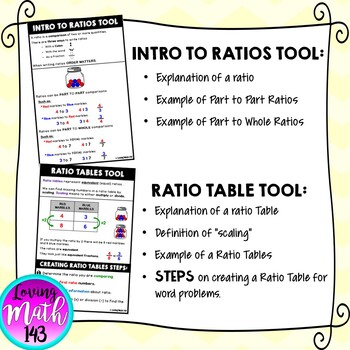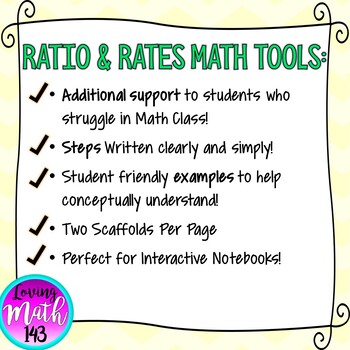Ratios and Rates: 6th Grade Math Scaffolds
- PDF
What educators are saying
Also included in
- This bundle for middle school math students includes everything you need when teaching ratios and proportions to 6th grade math students! Including: Ratios, ratio tables, unit rate, proportions, percents and conversions. WHATS INCLUDED:★ 3 Anchor Chart Posters★ 1 Matching Activity identifying equivaPrice $18.00Original Price $24.50Save $6.50
Description
Ratios & Rates: 6th Grade Math Scaffold
This resource is designed to support students who struggle in math class. It is a scaffold / tool to hand out to students who need additional help. This scaffold lists short and easy to read steps on how to problems involving ratios and unit rate.
The tools are 2 per page. Teachers can easily hand this to each child who needs an example and/or student friendly steps. It also makes a great addition to interactive math notebooks.
PERFECT FOR SPECIAL EDUCATION AND ENGLISH LANGUAGE LEARNERS!
***********************************************************************************************
HOW TO USE:
NO PREP NECESSARY! Simply make copies for your students! These scaffolds can work in black and white but would be best in color.
***********************************************************************************************
WHATS INCLUDED:
★ Introduction to Ratios: Examples & Definition
★ Ratio Tables: Example, Definition, and Steps.
★ Unit Rate: Example, Definition, and Steps
★ Comparing Unit Rates: Example, Definition and Steps.
★ Color coordinated and limited reading scaffold.
*******************************************************************************************
LICENSING TERMS: This purchase includes a license for one teacher only for personal use in their classroom. Licenses are non-transferable, meaning they can not be passed from one teacher to another. No part of this resource is to be shared with colleagues or used by an entire grade level, school, or district without purchasing the proper number of licenses.
COPYRIGHT TERMS: This resource may not be uploaded to the internet in any form, including classroom/personal websites or network drives, unless the site is password protected and can only be accessed by students.






